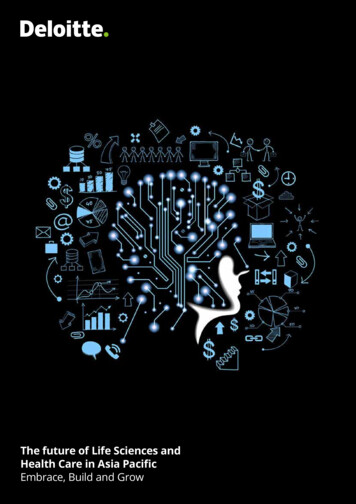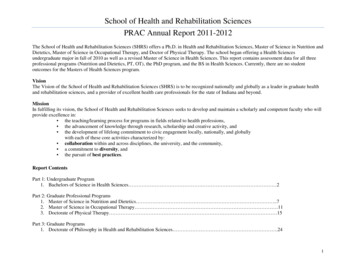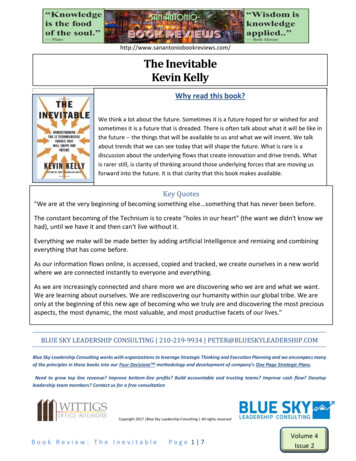
Transcription
The future of Life Sciences andHealth Care in Asia PacificEmbrace, Build and Grow
Introduction03Trends in Asia Pacific04Embrace06Build13Grow19The way forward26Contact us27
The future of life sciences and health care in Asia Pacific Embrace, Build and GrowIntroductionGiven that quality, outcomes, and value are the newbuzzwords for the Life Sciences and Health Care industry,stakeholders around the globe are looking for innovative, costeffective ways to deliver patient-centric, technology-enabledsolutions to patients both inside and outside hospital walls.In particular, emerging technologies – such as 3D printing,artificial intelligence, and Blockchain – are creatingtransformative opportunities for the industry, as scientificachievements continue at their record pace. In a myriadof ways, these technologies are helping to drive change bymaking health care delivery less expensive, more efficient, andmore accessible, while lowering costs, increasing speed, andenabling greater flexibility in the life sciences sector.On a macro level, we see many global trends play out similarlyin the Asia Pacific region. However, we must ultimately keepin mind that the region is a collection of markets with verydiverse sets of demographics, regulatory environments, anddisease profiles – and such disparities are often indicators thata varied array of unmet patient needs exist within the region.In this report, we detail several imperatives that we believeforward-looking Life Sciences and Health Care companiesshould consider. Specifically, they should Embrace exponentialchanges in technology and the shift from volume to value;Build a patient-centric focus and the new currency of data; andGrow new partnerships, operating models, and the workforceof the future.03
The future of Life Sciences and Health Care in Asia Pacific Embrace, Build and GrowTrends in Asia PacificDemographicLife expectancy73.7 yearsChinaJapan11431.4%millionChronic diseasesAs a result of rapidurbanisation, sedentarylifestyles, and rising obesitylevels, chronic diseases – oncethe hallmark of developedmarkets – are no longerconfined to these markets.China and India now have thelargest number of diabetessufferers in the world, ataround 114 million and 69million, respectively2.123404South Korea17.1%India69millionIn 2015, life expectancy at birth for theregion was 73.7 years on average, again of about 4.6 years since 20001.Ageing populationsBy 2050, more than a quarter – or 1.3billion – of the population in Asia Pacificwill be considered elderly, or 60 yearsor older3. In Australia, Japan, andSouth Korea, 18.5%, 31.4%, and17.1% of their respective populationswill be considered elderly, or above theage of 65, by 20284.Australia18.5%“Health at a Glance Asia/Pacific 2016”. OECD. 2016. e-expectancy-at-birth health glance ap-2016-5-en“2018 Global health care outlook”. Deloitte. 2018. -outlook.html“Ageing in Asia and the Pacific”. Economic and Social Commission for Asia and the Pacific. 0Ageing%20Fact%20Sheet%20Overview.pdfEconomist Intelligence Unit Data Tool.
The future of Life Sciences and Health Care in Asia Pacific Embrace, Build and GrowEconomicLao PDRUSD 98AustraliaUSD 4,357Per capita health careexpenditureThere is much variation in the per capitahealth care expenditure levels acrossAsia Pacific, ranging from USD 98 inLao PDR to USD 4,357 in Australia5.Electronic Health Records (EHR)The EHR market is likely to witness thefastest growth in Asia Pacific, with aforecasted compound annual growthrate (CAGR) of 5.7% until2023, on the back ofaggressiveEHRinvestments by5.7%governments,non-profitorganisations andthe private sector6.56MedTechUSD 13billion 3MedTechBy 2020, Asia Pacific’smarket for MedTechis expected to reachUSD 133 billion.“Health at a Glance Asia/Pacific 2016”. OECD. 2016. e-expectancy-at-birth health glance ap-2016-5-en“Global electronic health record market is projected to attain a size of 30.4 billion by 2023”. PR Newswire. 11 October 2018. 5
The future of Life Sciences and Health Care in Asia Pacific Embrace, Build and GrowEmbraceExponential changes in technologyWe are currently in an era of exponential change – a fourth industrial revolution. One of the implications of this trendon health care is its increasing digitisation, which would enable better management of population health data, andimprove patient engagement, product development and other commercial activities.Across Asia Pacific, local governments are prioritising information and communications technology development asone of their key national reforms. Earlier in 2017, for instance, the Chinese government issued its 13th Five-year Planon Science, Technology and Innovation detailing plans to develop technologies for precision medicine, establish amultilevel knowledge database, and create a national platform to capture and store biomedical big data7.Overall, we witness life sciences and pharmaceutical companies in the region leveraging the following exponentialtechnologies in a bid to cope with pressures from patent cliffs and escalating costs: 3D printing: With 3D printing comes the promise of a greater opportunity to customise patient treatment.In biologics, 3D printing is being explored as a new way of manufacturing cell and tissue products. Drugs anddisease models, for instance, can be tested on 3D-printed tissue instead of on animals or humans. When used incombination with nanotechnology, it can also be applied at a molecular level: for instance, customised white bloodcells can be designed to hunt down and attack cancer cells. While the potential of emerging technologies, suchas 3D printing, is well-recognised, regulations on these technologies remain nascent at this point in time, even inmore developed markets within the region, such as Australia (see Case Study 1 and 2). Artificial intelligence (AI): AI algorithms can analyse large data sets from clinical trials, health records, geneticprofiles, and pre-clinical studies. Patterns and trends within this data can help develop hypotheses at a muchfaster rate than researchers alone, and deliver new insights quickly. In Asia Pacific, a growing number of biopharmacompanies are using AI to streamline the drug discovery process, but its applications can also be found in otherareas such as diagnostics (see Case Study 3 and 4).706“Precision medicine and cancer immunology in China”. Science/AAAS Custom Publishing Office. 2 February 2018. tCRO supplement.pdf
The future of Life Sciences and Health Care in Asia Pacific Embrace, Build and Grow Blockchain: Blockchain, a shared, immutable record of peer-to-peer transactions built from linked transactionblocks stored on a digital transaction, enables each patient data source to act as a “block” of a complete,unalterable patient data profile that can then be shared securely with health care providers or other researchorganisations. Pharma companies can also use Blockchain to record irrefutable evidence on the performance ofa medicine and demonstrate adherence to a prescribed regimen. Other use cases of Blockchain include smartcontracts and evidence sharing between regulators and collaborators during the research and development(R&D) process. Indeed, the evidence in Asia Pacific shows that Blockchain’s true potential likely lies in its ability tofacilitate collaborations between different companies or even industries by enabling them to share digital assetswith one another (Case Study 5 and 6). Gene therapy: Gene therapy offers the potential for customised, targeted patient treatment, such as newCAR-T therapies (see Case Study 7). While the adoption of these therapies remain low, insights from humangenetics and precision medicine are already transforming health care through innovative biotechnology. Giventhat approximately 80% of rare diseases have a genetic origin8, gene therapy is expected to continue to play asignificant role in the treatment of rare diseases. Several approaches are also being explored in Asia Pacific forthe treatment of orphan diseases (see Case Study 8), such as the replacement of defective genes with healthyones, or the inactivation of a mutant gene (see Case Study 9).Case Study 1Australia puts in place reforms regulation for emerging technologiesIn addition to its pharmacovigilance initiative, Australia’s Therapeutic Goods Administration (TGA)is planning to put forward regulatory amendments for emerging technologies, covering technologicalinnovations such as health applications, diagnostic AI systems and the 3D printing of body parts9.According to the TGA, while such scientific developments continue to bring opportunities for Australians,they also require a regulatory framework that is “contemporary, adaptable, and supports innovation”. TheTGA has also said that it will continue to implement regulatory reforms, including those recommended by theExpert Panel Review of Medicines and Medical Devices Regulation, and propose amendments for the medicalapplication of 3D printing while being cognisant of international harmonisation10.Case Study 2Singapore rises as key player in medical manufacturingIn Singapore, the government has launched several key technology initiatives with direct impactson the medical manufacturing sector. These include programmes on 3D printing, robotics, and industrialapplications of the Internet of Things (IoT), to name a few. Under the Research, Innovation and Enterprise plan,for instance, SGD 3.2 billion has been allocated to advanced manufacturing and engineering research through202011. Earlier in July 2017, the National University of Singapore Centre for Additive Manufacturing was alsolaunched to help develop additive manufacturing, or 3D printing, technologies for the biomedical and healthcare fields.8“Rare Diseases and Orphan Products: Accelerating Research and Development”. The National Academies Press. 2010. https://www.ncbi.nlm.nih.gov/books/NBK561849 “TGA to reform regulation for software as medical devices as apps, AI and 3D printing in healthcare boom”. Healthcare IT News Australia.11 October 2018. d-printinghealthcare-boom10 “TGA to reform regulation for software as medical devices as apps, AI and 3D printing in healthcare boom”. Healthcare IT News Australia.11 October 2018. d-printinghealthcare-boom11 “Singapore dazzles as a world leader in medical manufacturing”. EDB Singapore. 13 April 2018. er-in-medical-manufacturing.html07
The future of Life Sciences and Health Care in Asia Pacific Embrace, Build and GrowCase Study 3AI decision support technology in AustraliaThe RippleDown technology, managed by Pacific Knowledge Systems in Australia, is a system integrated withwearable devices such as smartwatches, point-of-care devices, and fitness trackers, to encourage and motivate userengagement.According to current research, a third of wearable device users stop using their devices within half a year12. The integrationof RippleDown with wearable devices, however, enables the knowledge, expertise, and experience of world-class coaches,trainers, athletes, clinicians, physiotherapists, nutritionists, and other experts to be accumulated and made available tousers on a one-stop platform.The information is then applied contextually in real-time in response to the user’s health, fitness, and wellness datasources to provide personalised guidance and motivation and support the user in achieving their goals. This, in turns,helps to encourage long-term engagement, with positive impacts on the health, fitness, and wellness of the user.Case Study 4AI diagnostics in ChinaOne recent application of AI technology has been in the area of diagnostics. In 2017, China’s Tencent launchedan AI-powered diagnostic medical imaging service, known as its AI Medical Innovation System (AIMIS)13. Currently, thetechnology has demonstrated accuracy rates of over 90% for preliminary diagnoses of oesophageal cancer, 95% for lungsarcoidosis and 97% for diabetic retinopathy14.To date, AIMIS labs have been established in more than 10 hospitals, with agreements for further deployment at closeto 100 hospitals in China15. Tencent’s Youtu Lab, its AI research lab, is also collaborating with the Sun Yat-sen UniversityCancer Centre’s Oesophageal Cancer Research Institute in Guangzhou to leverage thousands of anonymised patient datato train the diagnostic component of its AI technology.Such a development could hold significant implications for the drug development process. For example, AIMIS imagescaptured by Tencent’s AI technology can be combined with XtalPI – a technology that leverages cloud computing platformssuch as Amazon Web Services, Tencent Cloud, Google Cloud, and Ali Yun, to run its algorithms through the deployment ofa million cores of computing power – to discover new products in silico, potentially drastically reducing the amount of timeand hefty investments required for pharmaceutical companies to discover new products.Case Study 5Asia Pacific developments in BlockchainGovernments in the Asia Pacific region are increasingly showing greater interest in Blockchain technologies, andthrowing their support behind its development through a number of policy changes and initiatives.The Monetary Authority of Singapore, for instance, embarked on a multi-phase collaborative project, known as ProjectUbin, with players in the financial services industry to explore the use of Distributed Ledger Technology for the clearingand settlement of payments and securities16.Meanwhile, in China, the government is exploring the use of Blockchain for the tracking of charity donations, with furtherplans to use the platform for a complete overhaul of the charity tracking system17.12 “Artificial Intelligence Decision Support Technology”. RippleDown. https://rippledown.com.au13 “How Tencent’s medical ecosystem is shaping the future of China’s healthcare”. TechNode. 11 February 2018. system14 “How Tencent’s medical ecosystem is shaping the future of China’s healthcare”. TechNode. 11 February 2018. system15 “How Tencent’s medical ecosystem is shaping the future of China’s healthcare”. TechNode. 11 February 2018. system16 “Project Ubin: Central Bank Digital Money using Distributed Ledger Technology”. Monetary Authority of Singapore. art-Financial-Centre/Project-Ubin.aspx17 “Why is Asia Pacific Blockchain industry growing so fast”. NewsBTC. 25 September 2018. ificblockchain-industry-growing-so-fast08
The future of Life Sciences and Health Care in Asia Pacific Embrace, Build and GrowCase Study 6Singapore invests in BlockchainAs part of its strategy to develop research-based, deep tech start-ups, SGInnovate, Singapore’sgovernment-owned innovation platform, has invested in MediLOT Technologies, a Singapore-basedBlockchain and health care analytics start-up, for an undisclosed amount18.Offering a health data protocol built on the principles of “patient centricity, privacy, and equitable datasharing”19, MediLOT’s solution is a dual Blockchain with a layered architecture incorporating AI and dataanalytics, on top of its control and data layers, that allows machine learning APIs and complex applications tobe built on top of its platform20.Case Study 7CAR-T clinical trialsThe advancement of clinical trials for the CAR-T immuno-oncology treatment is one illustrativecase of the potential that a convergence between the pharmaceuticals and biotechnology sectors can bring.Broadly, in the CAR-T process, a patient’s own immune cells, known as T-cells, are extracted, preserved,transported, and modified in the treatment of cancer.During the annual meeting of the American Society of Clinical Oncology held in June 2017, the Chinese firmNanjing Legend Biotech demonstrated that its CAR-T candidate could be a safe and effective way treatmentfor relapsed or refractory multiple myeloma21. Furthermore, 94% of patients whose multiple myeloma hadrelapsed after previous treatments had clinical remission within two months of receiving the experimentalproduct22. In the US, the Food and Drug Administration (FDA) has also approved the use of Tisagenlecleucel,which is marketed by Novartis as Kymriah, for the treatment of leukaemia23.Case Study 8China’s great leap into biotechnologyIn China, the medical industry is hard at work developing cheaper and more effective alternativesto Novartis’s Kymriah and Kite Pharma’s Yescarta, which are CAR-T therapies used for the treatment of acutelymphoblastic leukaemia and B-cell lymphoma respectively, that come with hefty price tags: Kymriah ismarketed at USD 475,000 per treatment, while Yescarta goes for USD 373,000.As of January 2018, there are 153 CAR-T studies in China – just 33 short of the number in the US. In Hainan,a Chinese resort island and free-trade zone for medical tourism in the region, a similar form of therapydeveloped by Innovative Cellular Therapeutics Co. has already been made commercially available for a price ofRMB 490,000 (USD 76,000) per treatment. Over the next three years, prices for CAR-T treatments in China areexpected to continue to fall to less than RMB 100,000 (USD 15,510)24.18 “How Singapore is using blockchain outside of cryptocurrencies”. CIO Asia. 6 September 2018. pto-currencies.html19 “Our solution”. MediLOT. October 2018. https://medilot.com/our-solution20 “How Singapore is using blockchain outside of cryptocurrencies”. CIO Asia. 6 September 2018. pto-currencies.html21 “After impressing at ASCO, Legend gains Johnson & Johnson as new CAR-T partner”. FierceBiotech. 22 December 2017. 22 “CAR T Cells: Expanding into Multiple Myeloma”. National Cancer Institute. 12 June 2017. blog/2017/car-t-cell-multiple-myeloma23 “FDA approval brings first gene therapy to the United States”. U.S. Food and Drug Administration. 30 August 2017. ncements/ucm574058.htm24 “China’s great leap into biotech”. Bloomberg. 18 January 2018. s-109
The future of Life Sciences and Health Care in Asia Pacific Embrace, Build and GrowCase Study 9Japan’s first gene therapy?Earlier in January 2018, AnGes, Inc., submitted its application for marketing approval to Japan’sPharmaceuticals and Medical Devices Agency for its HGF plasmid, an investigational gene therapy for thetreatment of critical limb ischemia, the most severe condition of peripheral arterial disease25.This marks the second time that AnGes is submitting beperminogene for approval from Japan's healthministry, after having withdrawn its first application due to a lack of data26. It is, however, more optimistic thistime as a result of the introduction of a conditional early approval system for regenerative medicine and genetherapies introduced by the Japanese government in its bid to make Japan a leader in advanced medicine.Under this fast-track scheme, a company can release a product conditionally, collecting additional data whilethe treatment is in use to be later submitted for formal approval27.If approved, the product – which could become the first commercial gene therapy product in Japan – canhelp to alleviate the symptoms of critical limb ischemia, a condition marked by reduced blood flow to theextremities, leading to pain and even gangrene. The product is designed to be injected directly into the feet,where it promotes the regeneration of blood vessels.According to estimates by Anges, its gene therapy would be suitable for approximately 10% of the 100,000 to200,000 people in Japan suffering from this condition, whose alternative would be to undergo surgery28.The shift from volume to valueWith escalating health care costs, governments, health care providers, and other stakeholders across Asia Pacificare recognising the benefits of keeping individuals and populations healthy. As a result, the needle is increasinglymoving from treatment to prevention, and from volume-based payment models to value-based ones.With an ageing population and the rise of chronic diseases within the Asia Pacific region, the need for suchinterventions has only grown more acute in recent years. A number of markets have begun this transition fromvolume to value in earnest, through reform policies and programmes promoting operational efficiency, technologyuse, and population health. In other words, a successful transition to value-based care requires stakeholders,including consumers, to move from health care to health; from treatment to prevention; and from individual topopulation health.In Japan, for instance, the government has introduced a series of reforms, including the establishment of anIntegrated Community Care System that combines health care, long-term care, housing, and livelihood supportservices in a unified manner so that Japan’s elderly can receive continuous quality care in their local communitiesinstead of the hospital29. Indeed, many sector stakeholders, particularly in those with advanced health systems inthe region, are now advocating the shift from a “break-fix” model of health care to one focused on prevention andthe overall holistic health of populations rather than episodic and transaction-based treatments (see Case Study10).25 “AnGes Submits Application for Marketing Approval to PMDA for HGF gene therapy for Critical Limb Ischemia”. GlobeNewswire. 22 January2018. al-Limb-Ischemia.html26 “Bioventure AnGes MG tries again to market Japan's first gene therapy”. Nikkei Asian Review. 10 June 2017. y27 “Bioventure AnGes MG tries again to market Japan's first gene therapy”. Nikkei Asian Review. 10 June 2017. y28 “Bioventure AnGes MG tries again to market Japan's first gene therapy”. Nikkei Asian Review. 10 June 2017. y29 “2018 Global health care outlook”. Deloitte. 2018. -outlook.html10
The future of Life Sciences and Health Care in Asia Pacific Embrace, Build and GrowOne emerging area of policy is that of population health, that enables providers to manage care – from preventiveand maintenance care to acute and long-term care – for a defined population. With the objective of using healthcare resources effectively and efficiently to improve the lifetime health and well-being of a specific population, themost successful population health policies often deploy innovative delivery models, employ the use of data andanalytics to identify at-risk patients and target services that reduce their use of expensive and low-quality care, andare underpinned by value-based payment contracts for the successful execution of these processes.Ultimately, the goals of population health management are critical: improving clinical effectiveness, lowering costs,sharing accountability, enhancing safety and, most importantly, keeping an entire population healthier. But strivingto achieve these goals is both challenging and complex. In Asia Pacific, population health efforts range fromminimal to robust and are as diverse as the markets that they exist in (see Case Study 11).Case Study 10Singapore’s '3 beyonds'In its bid to ensure the quality and affordability of its health care services into the future, Singapore’sMinistry of Health recently introduced its '3 beyonds' strategy30: Beyond health care to health: Initiatives are designed to create a healthier nation that would requireless of the health care system, and include efforts to get people to opt for healthier meals, a “war” againstdiabetes, and highly subsidised health screening for people aged 40 years and above. Beyond hospital to community: Initiatives are designed to enable people to receive the appropriatecare at home or within their communities, thus avoiding frequent hospital admissions, and include postdischarge visits to patients' homes by nurses and care workers. Beyond quality to value: Initiatives are designed to ensure value for money while retaining or increasingquality of care, and include the introduction of fee benchmarks, and the creation of the Agency for CareEffectiveness that was set up in 2015 to research treatments that provide the best value for money.At the same time, the Ministry of Health is also investing in automation initiatives to improve productivityas labour growth slows. Examples of these include a new robotic bottle medication dispensing system thatautomatically loads, picks and packs, as well as fastens water-proof and tear-proof labels onto medicationbottles31.30 “The '3 Beyonds': Singapore's strategy to sustain quality healthcare as demand rises”. The Straits Times. 30 November 2017. ealthcare-as-demand-rises31 “Improving productivity key to delivering good healthcare service: MOH”. Channel NewsAsia. 17 January 2017. are-service-756296011
The future of Life Sciences and Health Care in Asia Pacific Embrace, Build and GrowCase Study 11Population health management in Asia PacificChinaIn October 2016, China launched its Healthy China 2030 blueprint, declaring public health a preconditionfor future economic and social development. It details five specific goals, including the need to improve thenation’s health, control major risk factors, and increase the capacity of the health system32.In addition, the blueprint is based on four core principles: health priority; reform and innovation; scientificdevelopment; and justice and equality33. As China’s first long-term strategic population health plan, it also aimsto grow investments in its “Big Health” sector to RMB 16 trillion by 203034.JapanIn July 2016, Japan’s government released the Asia Health and Human Well-Being Initiative, which aims to applyaspects of the Japanese health care and nursing care system in other ageing Asian countries, and to enableJapanese providers to expand their overseas footprint, especially in Asian countries that are facing rapidlyageing societies35.As part of this initiative, Japan's health ministry will also be supporting Asian students, chiefly from SoutheastAsia and India, studying at Japanese medical schools36. The Economic Research Institute for ASEAN and EastAsia, which the Japanese government is funding, will also be developing a framework to enable Japanesedoctors to conduct joint research and practice in other Asian countries37.32 “Healthy China 2030: A Vision for Health Care”. Value in Health Regional Issues. May 2017. S2212-1099(17)30026-2/abstract33 “Healthy China 2030: A Vision for Health Care”. Value in Health Regional Issues. May 2017. S2212-1099(17)30026-2/abstract34 “2018 Global health care outlook”. Deloitte. 2018. -outlook.html35 “2018 Global health care outlook”. Deloitte. 2018. -outlook.html36 “Japan offering financial aid to Asian medical students”. Nikkei Asian Review. 5 January 2018. dents37 “Japan offering financial aid to Asian medical students”. Nikkei Asian Review. 5 January 2018. dents12
The future of Life Sciences and Health Care in Asia Pacific Embrace, Build and GrowBuildA patient-centric focusGlobally, Life Sciences and Health Care companies are investing in their capabilities to advance patient centricity.In an evolution of the “quantified self”, consumer engagement in and expectations of their health care experienceare growing, as they become more aware of the effectiveness of health interventions and sophisticated about theirdisease profiles and health risks.In Asia Pacific, we have witnessed the increasing adoption of regulated an
Build a patient-centric focus and the new currency of data; and Grow new partnerships, operating models, and the workforce . CAR-T therapies (see Case Study 7). While the adoption of these therapies remain low, insights from human genetics and precision medicine are already transforming health care through innovative biotechnology. Given











